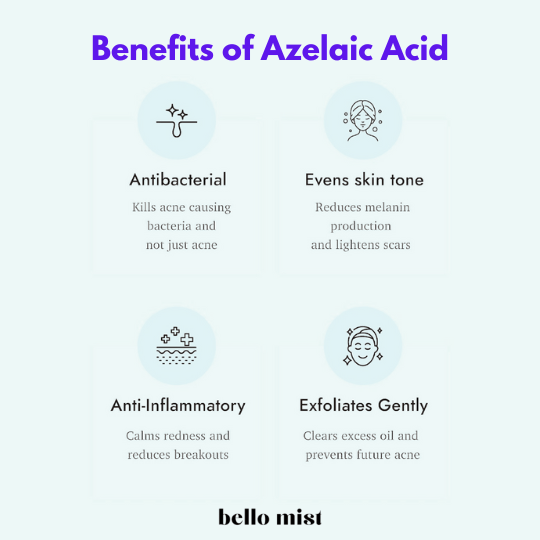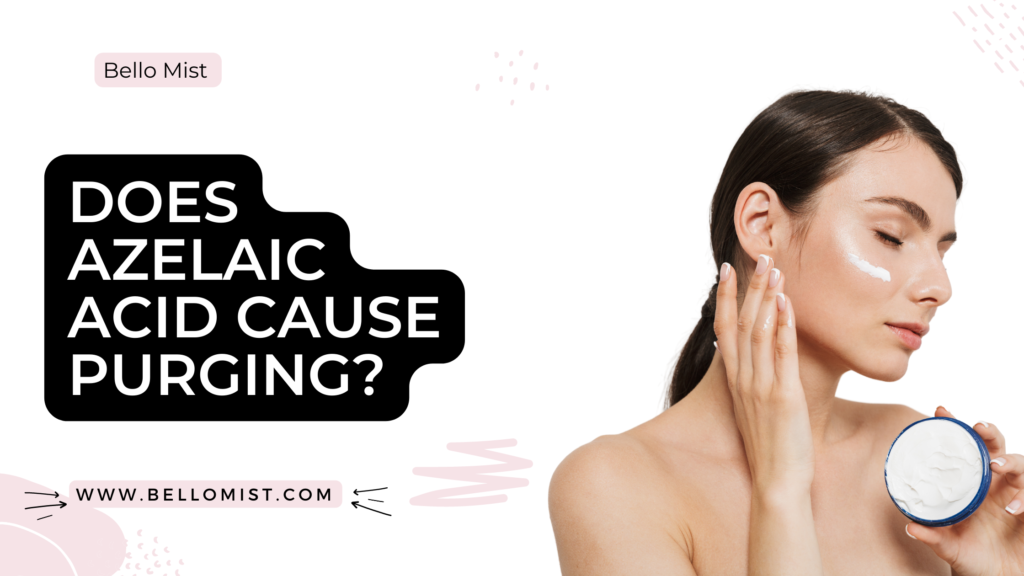Does azelaic acid cause purging? Let’s find out.
In recent years, azelaic acid has become one of the most talked-about ingredients in skincare products, with many claiming it works wonders for acne, rosacea, redness, and skin texture.
It fits all skin types and is usually considered gentle and non-irritating. Yet, since it’s an exfoliant, many people wonder if it might worsen their skin conditions before they get better. So, does azelaic acid cause purging?
If you want to add azelaic acid to your skincare routine, I will provide you with all the critical information about this fantastic ingredient.
What does azelaic acid do for the skin?
When determining, does azelaic acid cause purging? You must learn what azelaic acid does for your skin.
Azelaic acid is a naturally occurring element discovered in grains like wheat, barley, and rye, but the synthetic type is more commonly present in skin care products.
It has been approved by the FDA to treat acne and rosacea; however, it also has other advantages for the skin. Plenty of OTC azelaic acid products help combat a range of skin issues, such as inflammation, redness, scarring, and acne.
You can see the azelaic acid before and after image below.

Here are some of the benefits this ingredient can offer:
1. Fights Acne
Azelaic acid is a widely-used ingredient that is renowned for treating acne. It has antibacterial properties, making it very effective in eliminating acne-causing bacteria.
Unlike salicylic, glycolic, and alpha hydroxy acids, azelaic acid is an over-the-counter product that is strong enough to combat cystic acne.
Azelaic acid enters the pores and reduces the amount of free fatty acids on the skin, creating an environment that is hostile to acne-causing bacteria.
2. Removes Dead Skin Cells
Azelaic acid helps to get rid of dead skin cells on your skin, leaving you with clean and clear pores. This is because it has similar keratolytic qualities as salicylic acid and benzoyl peroxide. It’s important to note that this can help to prevent future breakouts from forming.
3. Fades Melasma And Acne Scars
Azelaic acid reduces melanin production by blocking tyrosinase, an enzyme necessary for creating melanin. In other words, this acid hampers the enzyme’s performance, ceasing melanin production.
Such a decrease in melanin lessens hyperpigmentation, particularly dark spots not caused by the sun. In short, applying topical azelaic acid decreases melanin production, reducing the visibility of melasma and acne scars.
4. Anti-Inflammatory
Azelaic acid has anti-inflammatory properties, reducing the discomfort of acne, rosacea, and other inflammations. People with acne-prone skin can experience a calming effect from breakouts with azelaic acid and prevent new blemishes. Those with rosacea may find a soothing of the redness through azelaic acid.
5. Smooths Texture
Azelaic acid, being an exfoliant, is a perfect solution to enhance skin texture. It works to break the bonds that keep dead skin cells together, leading to a glowing, smoother, and softer complexion.
With many beautiful benefits, it’s no surprise that it is now a popular skincare ingredient. Let’s learn more about our topic- does azelaic acid cause purging?

What are the side effects of using azelaic acid?
When determining, does azelaic acid cause purging? You must learn what skin purging is.
Azelaic acid is safe to use, but as with any other product, you should consider the potential side effects. Depending on your skin type, you may experience dryness, irritation, itching, redness, burning, tingling, or peeling – all of which are usually mild and will dissipate after a few days.
However, swelling, blisters, and hives are rare side effects, and you should cease usage immediately if any of these arise. It’s always best to speak with a dermatologist before trying any new product, particularly if you have sensitive skin.
What is skin purging?

Does azelaic acid cause purging? What is skin purging?
When you commence with a new skincare product, you may notice breakouts in the areas usually affected by acne. This is known as ‘skin purging.’
It occurs because approximately 30% of the pores in your skin contain microcomedones, even in severe cases of acne. Microcomedones are small pouches with oil, bacteria, and dead skin cells that block the pores and cause pimples.
From my experience, it requires about 8 weeks for a microcomedone to become visible on the skin. In the long run, skincare products that increase your skin’s natural exfoliation rate are advantageous as they prevent the emergence of fresh pimples and microcomedones.
Initially, you may be tempted to stop using these skincare ingredients when purging occurs. But you should continue with them, as it will help clear the breakouts more quickly, and you won’t have to encounter such frequent breakouts when you get through the initial purging. Let’s learn more about our topic- does azelaic acid cause purging?
Purging vs. breakout
When determining, does azelaic acid cause purging? You must know the difference between skin purging and breakout.
A breakout is probably a sign of purging when introducing azelaic acid into your routine. However, it may not be the case. Breakouts can also occur by skin irritation from a skincare product. It can be challenging to tell the difference between the two, but a few indicators can help.
The breakouts should be in areas you usually get them and should clear up quickly if you stick with the product. On the other hand, if the breakout appears in unexpected places and it takes longer to clear up, it’s likely irritation from the product. It may even get worse if you keep applying the product.
Ingredients and treatments that spur purging include retinoids (like retinol and retinal), AHAs (like glycolic acid and lactic), and BHAs (e.g., salicylic acid).

Does azelaic acid cause purging?
Does azelaic acid cause purging? Yes. As an exfoliant, it accelerates the renewal of skin cells, which in turn can increase breakouts.
Though this is usually a temporary occurrence, and your skin should adjust within a few weeks, you may need to cease using azelaic acid if you keep having breakouts after this period.
Additionally, it is essential to note that purging should take place only in areas where you usually get breakouts.
If you break out in areas where you don’t usually have eruptions, it could be a sign that you are not purging, and I recommend you stop using azelaic acid. Let’s discuss more about- does azelaic acid cause purging.

What to do when azelaic acid causes purging?
You may not be able to stop azelaic acid from causing skin purging entirely, but there are some ways to lessen its severity.
- When introducing your skin to azelaic acid, it’s a good idea to start small. Whether you go with over-the-counter products or a prescription, begin with the lowest available concentration and increase it after your skin adjusts.
- Just like you should begin with a mild concentration, you should gradually introduce azelaic acid into your routine. Start using it every other day or a few times a week. When your skin gets accustomed to it, you can increase your frequency as required.
- Don’t expect to see outcomes immediately when using a new product or active ingredient – your skin will require adjusting. Have patience and let it take up to 6 weeks. Remember that the purging process could last for an entire 6 weeks, so don’t give up before then.
- Use soothing skincare ingredients alongside azelaic acid to boost its anti-inflammatory effects (the size of acne pimples is generally down to how inflamed they are).
Try all these tips when starting your journey with azelaic acid to reduce skin purging.

How to use azelaic acid in the right way?
When determining, does azelaic acid cause purging? You must learn how to use azelaic acid correctly. If you want to utilize azelaic acid, it comes in various forms – creams, gels, and serums – so you can pick the one that works best for your skin type.
To begin, dermatologists suggest you apply it once a day in the evening, and if your skin handles it well, you can gradually use it twice daily.
Here’s a handy guide on how to use azelaic acid:
1. Start with clean skin
Give your face a gentle scrub, and blot off any moisture. If you’re trying azelaic acid for the first time, it’s wise to do a patch test. Put a dab of the product on your forearm and wait a day to be sure it won’t cause an adverse reaction. If everything looks okay, you can use it on your face.
2. Tone your skin
After thoroughly wiping away any traces of dirt, makeup, or oil from your face, you can use a toner that best suits your skin type. Take a cotton pad and delicately swipe the toner all over your face; however, make sure to avoid the eye area.
Doing so will allow the azelaic acid to efficiently get into your pores and give you the best results.
3. Apply azelaic acid
When applying azelaic acid, scoop up a small amount and spread it across your face. Massage it into your skin until it is completely absorbed. Be mindful not to get any near your eyes.
4. Moisturize
Use a hydrating moisturizer to combat dryness and inflammation. Additionally, wear sunscreen outdoors, as azelaic acid can make your skin more susceptible to sun rays. For those with drier skin, a moisturizer is an excellent addition.
And that’s it. Follow these easy steps, and you’ll be on your way to clearer skin.

Wrapping Up
Are you having acne issues? Azelaic acid could be the perfect solution for you. This powerful ingredient will help to stop the bacteria responsible for acne, open blocked pores, and give your skin a brighter appearance.
But does azelaic acid cause purging? It is essential to note that you may go through a period of purging before seeing results, but the long-term benefits make it worth it.
So why wait any longer? Give azelaic acid a go today, and let us know how you feel about this fantastic product in the comment section.
Read More
How to use azelaic acid and vitamin C for flawless skin?
Combining azelaic acid and retinol: Benefits and how to use safely
Does niacinamide cause purging? Uncovering the truth
Can hyaluronic acid cause acne? Here’s what you need to know
